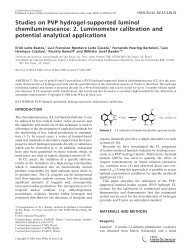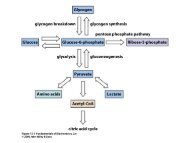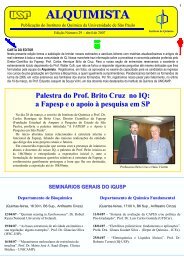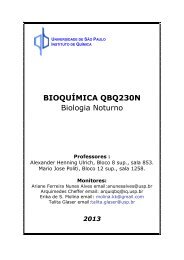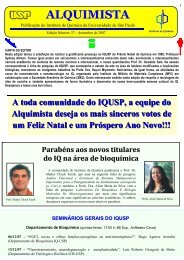2002 - Instituto de QuÃmica - USP
2002 - Instituto de QuÃmica - USP
2002 - Instituto de QuÃmica - USP
Create successful ePaper yourself
Turn your PDF publications into a flip-book with our unique Google optimized e-Paper software.
Sergio Verjovski-AlmeidaSTRUCTURE AND FUNCTIONOF ATPASESSergio Verjovski-Almeida, Ph.D., M.D., is grouplea<strong>de</strong>r of the Laboratory of Structure and Functionof ATPases. His group works with calcium-ATPasefocusing on un<strong>de</strong>rstanding at the molecular level themechanism of energy conversion involved in ion transportcatalyzed by this enzyme and with Schistosomamansoni ATP-diphosphohydrolase a membrane protein.His lab was a member of the Xylella Genomeproject, completed in March 2000, which has sequencedXylella fastidiosa, the first plant pathogento have its genome completely sequenced. Verjovski-Almeida coordinated one of the five sequencing centersfor the FAPESP/Ludwig Institute “Human CancerGenome Project”. This two-year project aimed atobtaining 1,000,000 EST sequences from humantumor cells, a goal that was reached on March 2001.His group is currently working on the multi-disciplinaryresearch project called “CAGE- Cooperation forAnalysis of Gene Expression”. Verjovski-Almeida coordinatesCAGE/Cancer, a cooperation between theInstitute of Chemistry, the Albert Einstein JewishHospital/SP and the Cancer Hospital, National CancerInstitute/RJ, <strong>de</strong>voted to explore the large collectionof acquired ESTs and to study differential geneexpression in prostate cancer. The figure shows a DNAmicroarray built and analyzed in our laboratory. Genesthat are over-expressed in prostate cancer appear red,those not changed in cancer when compared to normalprostate are yellow, and the genes that are downregulatedin cancer appear green. The aim of theproject is to characterize novel molecular markers fordiagnostic and prognostic purposes. Verjovski-Almeida coordinates the Schistosoma EST GenomeProject, a network of nine research laboratories inthe State of São Paulo fun<strong>de</strong>d by FAPESP to generate180,000 EST sequences from the parasite. Theaim is to characterize novel genes that could be newdrug targets or candidates for a vaccine. More aboutthis research may be found at http://verjo2.iq.usp.br/References:Frohme, M., Camargo, A., Czink, C., Matsukuma, A., Simpson, A.,Hoheisel, J. and Verjovski-Almeida, S. - Directed gap closure in large scalesequencing projects. Genome Res. 11: 901-903, 2001Camargo, A., Samaia, H., Dias-Neto, E., Simão, D., Migotto, I., Briones,M., Costa, F., Nagai, M., Verjovski-Almeida, S., Zago, M., et al. - Thecontribution of 700,000 “ORF sequence tags” to the <strong>de</strong>finition of thehuman transcriptome. Proc. Natl. Acad. Sci. USA 98: 12103-12108, 2001J. Fietto, R. DeMarco and S. Verjovski-Almeida - Use of <strong>de</strong>generate primersand touchdown PCR for construction of cDNA Libraries. BioTechniques32:1404-1411, <strong>2002</strong>J. Meidanis, M. Braga and S. Verjovski-Almeida - Whole Genome Analysisof Transporters in the plant pathogen Xylella fastidiosa. Microbiol.Molec. Biol. Rev. 66(2): 272-299, <strong>2002</strong>.<strong>Instituto</strong> <strong>de</strong> Química - Pesquisa 2001 - <strong>2002</strong> 94 Departamento Departamento <strong>de</strong> Química <strong>de</strong> FundamentalBioquímica



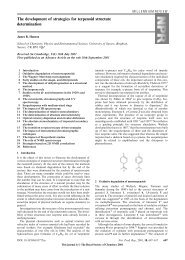
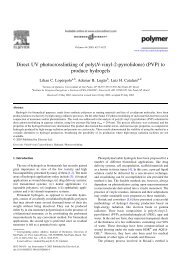
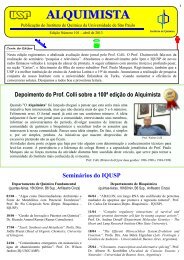
![PE]+ + N. Fragmentação por clivagem sigma](https://img.yumpu.com/50134385/1/180x260/pe-n-fragmentaaao-por-clivagem-sigma.jpg?quality=85)
